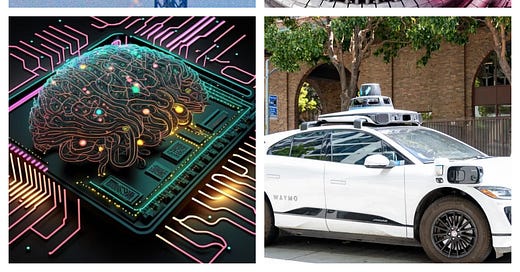TL;DR the pendulum of innovation and capital swung too far toward software in the past decades, and now the course correction is opening up incredible opportunities with deep-tech and hardware integration. The silver lining of the backlog is new technologies allow us to build better, cheaper, greener, faster as we race to win the industries of the next century. For early-stage investors the opportunity couldn’t be more exciting – but beware of upfront overspend seemingly justified by massive outcomes. De-risking crucial technologies step by step and milestone by milestone is the only way to balance risk and reward. Welcome to the next wave of foundational, defensible companies that move our society forward. Those who do it right will help shape our future and reap great rewards.
Is it just because we are inspired seeing driverless cars take us safely around San Francisco or chopsticks grab a rocket instead of crashing into Earth? Is it simply because our way of life is threatened, having outsourced a key piece of our tech manufacturing to Taiwan, and the rest of it to other parts of Asia? Is it only because our airports and highways are crumbling? Is it just because for far too long software businesses captured the profits of others’ investments in physical infrastructure? Is it simply because ZIRP and short-termism led venture investors to pick low-hanging fruit? Is it only because new technologies will allow us to rebuild everything better, cheaper, cleaner, faster?
No. It is because of all of the above that we are entering a golden age for hardware and deep-tech.
The End of Software Dominance
Venture capitalists’ software-only mantra in recent decades was understandable – the irresistible allure of low fixed costs, high margins, and the promise of unlimited scalability – but not viable in the long-term (and we’d argue persisted too long for a highly-illiquid asset class).
’s 2011 “software is eating the world” essay captured the zeitgeist. The siren song of SaaS compounded by ZIRP-era irrationality extended this runway and led the entire industry down a path of underinvestment in hardware for over a decade. The excessive flow of capital to software-only businesses is now self-correcting, ending the era of software supremacy.Capital is fungible. If capital flows excessively into one sector, risk/reward falls out of balance, and over time capital re-allocates towards equilibrium. In efficient markets, high fixed cost businesses (meaning they require a lot of upfront investment before selling the first widget) enjoy high margins, and low barriers to entry businesses suffer the opposite. All else equal, differentiation (a brand, a patented formula, etc.) and/or better execution give businesses the ability to attain higher margins, but competition will typically erode this over time. In monopoly situations where this self-correcting mechanism of capitalism doesn’t work (for example AT&T’s control of fixed wire communications until the early 80s), governments can step in to fix this market inefficiency to the benefit of consumers.
In the past few decades, things changed. Low-tech, location-independent asset-intensive businesses were offshored as price competition intensified. In the high-tech space, the internet and mobile revolution created a huge opportunity. Once the expensive physical infrastructure was in place, software companies could build highly profitable businesses with minimal capital investment. This manifested in two ways:
Platform Giants: Major tech companies built data monopolies that didn't trigger traditional antitrust concerns since consumer prices remained low
Asset-Light Models: AirBnB used others’ real estate, Uber others’ cars. Smaller companies like UberEats, Instacart, and early (bookseller) Amazon profited by leveraging others' physical infrastructure
A perhaps relatable analogy comes from the world of media. There has been a longstanding debate regarding the supremacy of content vs. distribution. Who is king? While value has fluctuated in waves from one to the other throughout history, it seems to have now settled at an interesting hybrid. Old distribution gave way to content domination, and now the content leaders and the new distribution owners are each attempting to increasingly control their full destiny.
The technology world is confronting a similar situation. A world of hard asset domination gave way over time to software and data. But if all the returns flow to software, at some point the hardware players inevitably stop financing the infrastructure needed for a thriving economy and society. Could software-only businesses perpetually remain “king”? It seemed doubtful and the pendulum is now swinging back. Even the most successful "software-only" companies are investing heavily in physical infrastructure (Amazon has built massive logistics networks, tech giants are investing billions in data centers), and the new foundational companies are daringly building next-gen infrastructure, from chips to rockets to self-driving cars to drones to nuclear reactors. The long-term equilibrium requires both bits and atoms.
Why? Several Key Reasons:
Geopolitical Reality
The pandemic and rising global tensions have exposed the fragility of our supply chains and the dangers of technological dependence. Nations and companies alike are racing to secure their technological sovereignty
Infrastructure 3.0
Just like software suffers from “technical debt” when code is not kept updated, our physical backbone is suffering from “industrial and infrastructure debt” from decades of outsourcing our manufacturing and delaying investments in modernizing and expanding our infrastructure, from roads to bridges to housing to factories.
Energy Imperative
The undeniable strong correlation between energy usage and prosperity demands a continued push for more abundant and cheaper energy. While we push towards more resilient and clean sources, we cannot de-prioritize abundance and cost. The future requires more, cleaner, cheaper, and more distributed energy resources to power our increasingly advanced society
The Age of AI
The next “backbone” for communications requires new, expensive, more powerful chips and other technologies, and is growing rapidly. Notably, the CapEx spend of the leading “software-only” players is exploding
The Path Forward
The silver lining of the hardware backlog is we can leapfrog to use the most modern designs and technologies for our cities and factories of the future. Given the incredible acceleration of computing price/performance plus advances in biotech and physics, we have an unprecedented opportunity to rebuild everything from our cities to our factories with cutting-edge technologies based on our updated understanding of planetary resources, human preferences, climate change and technological innovation. Using new materials, more efficient hardware/software integration, more sustainable business models, and more distributed/resilient supply chains we can turbocharge our economy and improve global incomes and quality of life. At
, we believe the earliest stages of venture have an important role to play in this era, and that it represents the opportunity of a lifetime.Less than a decade after his software-focused missive,
recognized this pendulum shift and published “It’s Time to Build” in 2020 (though the ZIRP behavior immediately thereafter didn’t reflect much translation into action). More interestingly, it’s worth noting another leading venture capitalist made this clarion call much earlier - and invested accordingly. In 2013, Peter Thiel famously said “we wanted flying cars. Instead we got 140 characters”, embodying the bold vision of one of the most successful venture funds of our generation (Founders Fund). However, despite these loud voices, the venture industry has been stubbornly slow to let go of the old mantra - a surprising fact given the inherent need to make bold bets and think long-term to succeed in this asset class.A Word of Caution
The scale of the opportunity is likely to lead overzealous investors to fund new ideas indiscriminately and over-capitalize opportunities in the hopes of justifying all mistakes with the power law. But just because the opportunity is huge, does not mean that all companies will win. More importantly, overcapitalizing potential winners is unlikely to help them succeed. Picking the right startups and guiding them/funding them with milestone-based disbursements is the right way to both increase the odds of success of each individual company, and in aggregate optimize the risk/reward for diversified investors. The craft of company building does not go away simply because the prize is huge.
In Conclusion…
We're not just witnessing another tech cycle. This is a fundamental reorientation toward building real things that advance society and preparing for new technologies and new physical and geopolitical realities. The pendulum swing from software to hardware and deep tech isn't just inevitable – it's essential for our future and it’s here. For too long, we chased short-term profits through offshoring and software arbitrage. That era is ending. The future belongs to those who dare to build, who embrace the challenge of creating physical products and infrastructure, and who understand that true innovation requires both bits and atoms. This is not a carte blanche to overspend nor overfund, rather a call to build the next foundational companies of our $100T+ economy. This is our generation's moment to rebuild, reimagine, and recreate the physical world. The tools are ready, the capital is available, and the need has never been greater. Welcome to the golden age of hardware and deep tech.
To discuss or learn more about Avila VC please reach out to us.
Follow us for sporadic postings on LinkedIn and X, and Patty Wexler on Medium








